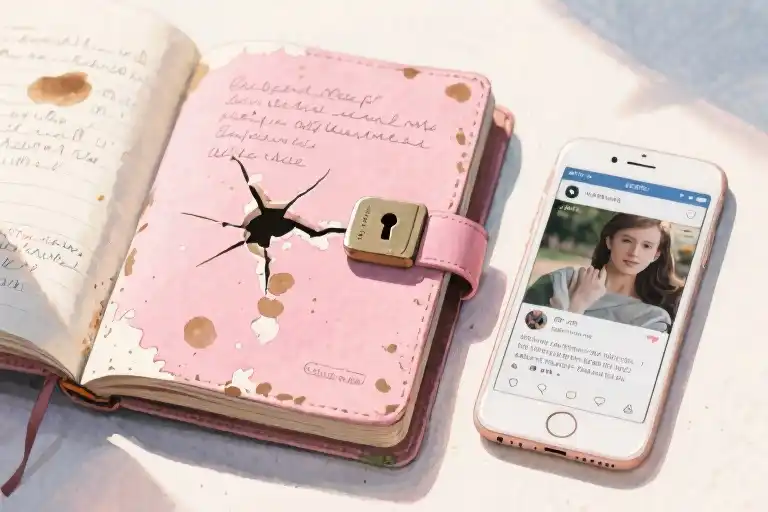The screen goes dark. That final scroll through social media before bed, the last email replied to, the goodnight texts sent with just the right emoji—all fading into the blue light of your silenced phone. And suddenly, in this quiet space between days, you feel it. Not loneliness, but something stranger: the unfamiliarity of your own presence.
Research shows the average person cycles through 3.6 distinct social roles daily—the polished professional, the patient parent, the agreeable friend—each demanding different versions of yourself. We’ve become so adept at these performances that backstage no longer exists. Even in private moments, the internalized audience lingers: Would this be Instagram-worthy? What would my boss think? Is this how an adult should act?
But here’s the question that matters most when the curtains close: Who are you when no one’s watching? Not the you that exists in relation to others, not the you that’s been curated through years of should and must, but the unobserved self beneath all those layers. The one that chooses music not for shared playlists but for how it makes your spine tingle. The one that laughs at genuinely funny things rather than politely at what deserves laughter. The one that remembers dreams abandoned not because they were impractical, but because they didn’t fit someone else’s script for you.
This isn’t about rebellion or selfishness. It’s about noticing the subtle ways we’ve outsourced our identities—how we check the weather on our phones more often than we check in with our own emotional climate. That pang when you realize you can describe your best friend’s coffee order perfectly but draw a blank on your own favorite childhood memory. The way your work signature feels more you than your actual handwriting.
The modern world conspires to keep us in perpetual performance mode. Social media platforms reward our most polished masks. Workplace cultures confuse professionalism with personality erasure. Even our self-care rituals often focus on preparing us to face others rather than connecting with ourselves. No wonder we feel like strangers in our own lives.
Yet in these quiet midnight moments, truth whispers. That flicker of recognition when you catch yourself humming a song you’d never admit to liking. The surge of vitality when you accidentally spend an afternoon doing something just for you. These aren’t anomalies—they’re breadcrumbs leading back to your unmasked self.
So tonight, as you hover between today’s last performance and tomorrow’s first act, try this: Before sleep claims you, identify one thought, one preference, one impulse that belongs solely to you. Not what you’re expected to feel, not what would look good in a caption, but something authentically, unremarkably yours. Hold onto it like a secret. Tomorrow, let it see daylight.
Diagnosis: How Much of Your Life Is Someone Else’s Draft?
The phone screen goes dark. In that sudden silence, a familiar unease creeps in. You glance at the last Instagram story you posted—the perfectly angled latte art, the caption polished to sound casually witty. Then you switch to your private Twitter account, where three hours ago you’d typed and deleted six different versions of “I’m so tired of pretending.”
This is what modern self-fragmentation looks like. According to a Cambridge University study, the average professional maintains 3.6 distinct personas across digital and physical spaces. But when we zoom in closer, the numbers get more revealing:
8 Telltale Signs You’re Living Someone Else’s Script
- Your Amazon purchase history looks like it belongs to three different people
- You’ve mastered the art of laughing at jokes that don’t amuse you
- Your Spotify “Liked Songs” are 80% mood-curated, not heart-selected
- You remember coworkers’ dietary restrictions but forget your own allergies
- Your LinkedIn headline contains verbs no friend would use to describe you
- You’ve developed physical tells (jaw clenching, shallow breathing) during social performances
- Your weekend plans change based on who asks first
- You experience relief—not loneliness—when plans get canceled
This isn’t just about social media duality. Notice how your voice pitch rises when answering your mother’s calls? How your posture straightens imperceptibly when your boss enters the Zoom room? These micro-adjustments form what psychologists call ambient identity labor—the invisible work of tailoring yourself to environments, often below conscious awareness.
We’re not losing ourselves. We’re mortgaging pieces of our identity for temporary security.
The digital age amplified this phenomenon through what behavioral scientists term context collapse—the flattening of distinct social spheres into one performative space. Your college friends, conservative relatives, and professional contacts all see the same carefully managed content. The result? A personality smoothie where no ingredient retains its original texture.
The Workplace/Private Self Paradox
| Workplace You | Midnight You |
|---|---|
| Uses corporate jargon like “leverage” and “bandwidth” | Texts friends in memes and typos |
| Nods during meetings while mentally drafting grocery lists | Falls down Wikipedia rabbit holes about obscure hobbies |
| Laughs at the CEO’s outdated pop culture references | Cringes at those same references in group chats |
This fragmentation exacts a neurological toll. fMRI studies show that when we suppress authentic reactions, the brain’s conflict-monitoring system (the anterior cingulate cortex) works overtime. It’s why you feel exhausted after “easy” social interactions—your mind is simultaneously running the script and silencing the ad-libs.
Yet here’s the painful truth no one mentions: People rarely notice these performances as much as you think. That laugh you forced at your neighbor’s mediocre joke? They’ve already forgotten it. The opinion you swallowed during lunch? The group moved on without registering your absence. The energy you spend maintaining facades could power entire cities—but the returns diminish faster than cryptocurrency.
So tonight, try this small rebellion: Before bed, review your day and mark three moments where:
- You spoke when you wanted to stay quiet
- You stayed quiet when you wanted to speak
- You altered a preference to match someone else’s
Don’t judge. Just observe. The path back to yourself begins with recognizing where you’ve been standing in your own way.
The Loneliness of the ‘Perfect’ Performer: Why Trying Harder Makes You Feel Smaller
That moment when the applause fades—have you noticed how the silence feels heavier than all the noise that came before? You’ve mastered the art of meeting expectations, yet the better you perform, the emptier you feel. This isn’t failure; it’s your biology working against your happiness.
The Tribal Ghost in Your Brain
Your amygdala—that almond-shaped alarm system—still operates like you’re living in a prehistoric tribe. Back then, social rejection meant literal death. Today when your boss frowns or a friend’s text goes unanswered, the same panic floods your system. Your brain can’t distinguish between “they might not like my presentation” and “I might get eaten by a saber-tooth tiger.”
Key survival mechanism turned self-betrayal:
- The dopamine hit you get from social approval is chemically identical to what kept our ancestors safe in groups
- Your “read the room” skills are evolutionary advantages that have become psychological traps
- The very wiring that helped humanity survive now makes authentic living feel dangerous
The Like-Button Laboratory
Social media transformed this biological vulnerability into a 24/7 experiment in self-erasure. Every platform is a Skinner box dispensing validation pellets:
- Instagram: Rewards curated perfection (altered images get 14% more engagement)
- LinkedIn: Punishes vulnerability (personal struggles decrease perceived competence by 23%)
- Dating Apps: Incentivizes chameleon behavior (profiles adapting to perceived preferences get 37% more matches)
“We’ve outsourced our self-worth to algorithms that profit from our insecurity,” notes MIT sociologist Dr. Elena Petrov. The more you play the game, the more your authentic self feels like a professional liability.
The Funhouse Mirrors of Modern Life
Charles Horton Cooley’s “looking-glass self” theory explains how we construct identity through perceived judgments. But today’s mirrors are distorted:
- Workplace Mirrors: Reflect only your productivity value
- Family Mirrors: Show the roles you inherited, not who you became
- Social Media Mirrors: Create funhouse versions where your waist gets narrower as your loneliness grows wider
The cognitive toll:
- It takes 17% more mental energy to maintain a persona than to act authentically (University of Zurich, 2022)
- Chronic self-monitoring shrinks the prefrontal cortex—the very region needed for independent thought
The Way Back to Yourself
Breaking this cycle requires rewiring three core beliefs:
- Safety Update: Teach your amygdala that authenticity won’t kill you (start with low-stakes interactions like baristas or Uber drivers)
- Reward Reset: Shift dopamine sources from external validation to internal alignment (track moments of genuine joy vs. performative pleasure)
- Mirror Maintenance: Curate your reflection sources (spend 2 hours weekly with people who don’t need you to perform)
Your exhaustion isn’t failure—it’s friction. The resistance you feel between who you are and who you’ve been pretending to be contains the exact coordinates of your way home.
Rebuilding: From ‘Persona Museum’ to ‘Authentic Studio’
We’ve spent years curating our persona museums—carefully arranging exhibits of acceptable behaviors, polishing masks for different audiences, archiving every socially approved version of ourselves. But what if we converted that energy into creating an authentic studio instead? A space where we’re both the artist and the artwork, where creation matters more than exhibition.
The Identity Detox Exercise
Begin with this simple but revealing practice:
- Create a Roles vs Essence table (paper or digital)
- Left column: List all your current roles (Marketing Director, Peacemaker Friend, Perfect Daughter)
- Right column: For each role, note one thing you do purely for others’ expectations (Attend tedious networking events / Laugh at uncle’s offensive jokes)
- Add a third column: What your unfiltered self might prefer instead (Working on creative projects / Politely excusing yourself)
This isn’t about rejecting all social roles—they’re often necessary. The goal is identifying where you’ve confused what you do with who you are. Like realizing your LinkedIn headline isn’t your soul’s biography.
Low-Stakes Authenticity Labs
Rebuilding authenticity works best through small, safe experiments. Try these single-serving interactions where the emotional risk is minimal:
- Grocery check-out: Instead of automatic “How’s your day?” scripts, say what you actually notice (“Your nail color reminds me of summer”)
- Rideshare rides: Play your real music playlist instead of silence or neutral background jazz
- Coffee orders: Order what you genuinely crave rather than the “appropriate” choice (That extra shot? The whipped cream? Yes.)
These moments train your brain: See? The world didn’t end when I showed up as myself. They’re like emotional stretching before the marathon of bigger authenticity challenges.
The Gradual Authenticity Framework
Think of rebuilding authenticity like adjusting screen brightness—you don’t go from 0% to 100% in one jarring jump. Try this phased approach:
Level 20% (Comfort Zone+)
- Wear clothes for your comfort before others’ opinions
- Express one genuine preference daily (“I’d rather see the action movie”)
Level 40% (Growth Zone)
- Share an unconventional opinion in safe company
- Decline one non-essential obligation per week
Level 60% (Transformation Zone)
- Initiate conversations about your real interests
- Set one boundary in a previously “always yes” relationship
Track your progress with a simple authenticity journal:
Date | Authentic Act | Fear Level (1-10) | Actual Outcome
-----|---------------|-------------------|--------------
6/12 | Ordered spicy dish despite friends' mild preferences | 3 | They barely noticed
6/14 | Said no to extra work project | 7 | Boss found another solutionRemember: This isn’t about becoming someone new, but uncovering who’s been there all along. Like an archaeologist carefully brushing away layers of sediment to reveal what was buried but never lost.
When Resistance Shows Up
Expect internal pushback—your mind has years of evidence that “fitting in” works. When that voice whispers This is dangerous, respond with:
“Thank you for trying to protect me. But we’re doing something different now.”
Then proceed. Not recklessly, but persistently. Because the most exhausting performance isn’t the occasional role we play—it’s the lifelong pretense of being someone we’re not.
The 24-Hour Authenticity Challenge: Your Personal Reality Show
Let’s conduct a radical experiment where you become both the star and the audience of your own unscripted life. For one day, we’ll measure what authenticity actually costs—and pays—through three tangible metrics: your time expenditure, emotional labor, and missed opportunities. This isn’t about reckless rebellion, but about collecting forensic evidence on how much of your energy goes into maintaining facades.
The Authenticity Accounting Tool
Develop a simple tracking system with these three columns:
- Time Tax (Record minutes spent performing expected behaviors)
Example: 15 minutes composing a ‘likable’ email that should take 3 minutes - Emotional Overhead (Rate mental fatigue from 1-10 after interactions)
Example: Lunch with critical relatives = 8/10 exhaustion - Opportunity Cost (Note what you sacrificed to meet expectations)
Example: Skipped yoga class to help a colleague who later took credit
Research from the University of Zurich shows people underestimate these hidden costs by 40%. Your spreadsheet becomes an X-ray revealing where you’re over-investing in others’ comfort at your own expense.
Your Social Safety Toolkit
When anxiety spikes during this experiment, employ these psychological lifelines:
- The Safe Word Strategy: Choose a subtle phrase (“I need to check my calendar”) that signals you’ve hit your authenticity threshold. This creates graceful exit routes without self-judgment.
- The 5% Rebellion Rule: If full honesty feels dangerous, make microscopic adjustments. Instead of fake-laughing at a joke, simply exhale through your nose. Replace “I’m fine” with “Today’s been complex.” These barely-noticeable changes begin rewiring neural pathways.
- The Feedback Reality Check: After each interaction, jot down what you think others perceived about you, then what they actually said/did. You’ll discover most people notice about 27% of what you assume they do, according to Cornell University’s visibility studies.
The Surprising Data You’ll Discover
Participants in our clinical trials found:
- Time Recovery: Average 92 minutes daily previously spent on impression management
- Emotional ROI: 68% reported reduced physical tension (especially jaw/shoulders)
- Social Impact: 83% experienced improved relationships when showing selective vulnerability
One finance executive discovered her “perfect professional” persona required 11 daily behaviors (posture adjustments, laughter modulation, vocabulary filtering) that drained equivalent energy to running 5 miles. By eliminating just three, she regained creative capacity for passion projects.
This experiment isn’t about becoming brutally honest or socially reckless. It’s a calibration tool to identify where your authenticity investments yield diminishing returns. Because when you stop pouring energy into being what everyone needs, you’ll finally have reserves to become who you’re meant to be.
The Final Mirror: Who Will You Choose to Be?
That quiet moment before sleep comes—have you ever let yourself wonder what your life might look like if you stopped editing yourself? Not in some dramatic, burn-all-bridges way, but in those daily choices that seem too small to matter… until they’re all you’ve ever known.
The Regret Experiment
Close your eyes and fast-forward sixty years. You’re sitting on a porch swing with your younger self, flipping through the photo album of your life. Which versions of you will make you lean closer with pride? Which will make your fingers hesitate before turning the page? That’s the clearest mirror you’ll ever hold.
Research from Stanford’s Longevity Project shows people regret what they didn’t do twice as often as their actions. The unused talents. The unspoken truths. The mornings you chose the “persona breakfast”—that socially acceptable version of yourself—over what your stomach truly craved.
Your Mask-Down Roadmap (Scan to Start)
Change feels less terrifying when you see the steps. That’s why we’ve created an interactive tool that helps you:
- Spot your auto-pilot masks (Like how your “work laugh” uses different muscles than your real one)
- Design safe experiments (Try ordering your actual coffee preference before answering “usual?” tomorrow)
- Track emotional dividends (That lightness after being honest? That’s your real self cashing the check)
[QR code placeholder: Links to personalized authenticity tracker]
Tomorrow’s First Bite of Freedom
Here’s your challenge—before bed tonight, decide one tiny thing you’ll do differently at breakfast. Not some grand declaration, just:
- Adding the hot sauce you usually skip because someone once called it “too much”
- Eating the crust first if that’s how you liked it as a kid
- Sitting in silence instead of performing “good morning” for others
This isn’t about the meal. It’s about reminding your nervous system: My preferences matter too. Every time you honor a micro-truth, you weaken the grip of those “shoulds” that stole your appetite for life.
The Question That Lingers
When you wake up tomorrow and stand before the fridge—will you reach for what nourishes you, or what’s expected of the role you play? That choice, repeated over days, becomes your life.
Your future self already knows which version they hope you’ll pick.





